 Presidents Day in 2014 is on Monday, February 17. Celebratory events will take place across the nation to honor the many accomplishments of our country’s leaders. It is a day to appreciate the rich history of our nation by exploring the past, appreciating the present, and constructing new understandings of our collective and diverse cultural heritage to inform our future.
Presidents Day in 2014 is on Monday, February 17. Celebratory events will take place across the nation to honor the many accomplishments of our country’s leaders. It is a day to appreciate the rich history of our nation by exploring the past, appreciating the present, and constructing new understandings of our collective and diverse cultural heritage to inform our future.
As teachers incorporate both digital and print resources about different presidents, the IRA Children’s Literature and Reading Special Interest Group (SIG) offers several recommendations for the K–12 classroom. The featured biographies contain fun facts about our nation’s leaders while situating significant events that shaped our history. The life stories also serve as building blocks to deepen understandings of the past and broaden discussions about tolerance, remind us of our rights and freedom, and encourage a “call to action” to serve our communities.
Since the biographies span various reading levels, teachers and students can use close and critical reading strategies to analyze and compare texts. More importantly, reading books about our presidents can launch critical conversations about free democracy, citizenry, and social action and change. There are also many ways to respond to biographies from using bio-cubes, researching and writing biographies, hosting “talk shows,” and writing letters, digital timelines, and bio-poems. ReadWriteThink has many lesson plans that can be adapted when using biographies.
Grades K-3
Meltzer, Brad. (2014). I am Abraham Lincoln. Illus. by Christopher Eliopoulos. New York: Dial.
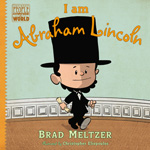 I Am Abraham Lincoln introduces readers to a young Lincoln, standing up against acts of intolerance, and remaining steadfast in his pursuit to read and write. As Abe said, “When it comes to learning, my best teachers were simply…books” (11). The message of speaking up for others is woven throughout: “The hardest fights don’t reveal a winner-but they do reveal character” (20). This biography focuses on Lincoln’s journey toward justice from his childhood to his Presidency. For instance, Lincoln’s commitment toward fairness led the country to abolish slavery. Through speech bubbles, comic-book style illustrations, and simple facts, this biography for “little hands” is a very good introduction into Lincoln’s life and contributions. The last two pages include one of Lincoln’s famous quotes and historical illustrations/photographs. Teachers will want to partner this biography with Abe’s Honest Words (2008) by Doreen Rappaport (Disney Hyperion) or Abe Lincoln: The Boy who loved books (2006) by Kay Winters (Scholastic).
I Am Abraham Lincoln introduces readers to a young Lincoln, standing up against acts of intolerance, and remaining steadfast in his pursuit to read and write. As Abe said, “When it comes to learning, my best teachers were simply…books” (11). The message of speaking up for others is woven throughout: “The hardest fights don’t reveal a winner-but they do reveal character” (20). This biography focuses on Lincoln’s journey toward justice from his childhood to his Presidency. For instance, Lincoln’s commitment toward fairness led the country to abolish slavery. Through speech bubbles, comic-book style illustrations, and simple facts, this biography for “little hands” is a very good introduction into Lincoln’s life and contributions. The last two pages include one of Lincoln’s famous quotes and historical illustrations/photographs. Teachers will want to partner this biography with Abe’s Honest Words (2008) by Doreen Rappaport (Disney Hyperion) or Abe Lincoln: The Boy who loved books (2006) by Kay Winters (Scholastic).
- Mary Napoli, Penn State Harrisburg
Winter, Jonah. (2013). JFK. Illus. by AG Ford. New York: Katherine Tegen Books/HarperCollins.
 This informative picture book biography chronicles significant moments of John F. Kennedy’s life. The author adds a personal connection to the story by explaining that he was a little boy, sitting on his father’s shoulders, when he saw Kennedy and his wife pass by during the 1963 Dallas motorcade. Then, within hours, JFK was dead. Winter offers readers with encouraging words: “It’s a story of hope and courage. It’s a story about the power of words” (4). The author provides readers with a glimpse into JFK’s upbringing, sickly childhood, unspoken competition with his older brother, and his passion with books. Information about JFK’s belief in public service and his presidential victory are highlighted with a quote from his famous inauguration speech: “Ask not what your country can do for you—ask what you can do for your country.” This biography pays tribute to JFK’s courage and how the power of words contributed to his service.
This informative picture book biography chronicles significant moments of John F. Kennedy’s life. The author adds a personal connection to the story by explaining that he was a little boy, sitting on his father’s shoulders, when he saw Kennedy and his wife pass by during the 1963 Dallas motorcade. Then, within hours, JFK was dead. Winter offers readers with encouraging words: “It’s a story of hope and courage. It’s a story about the power of words” (4). The author provides readers with a glimpse into JFK’s upbringing, sickly childhood, unspoken competition with his older brother, and his passion with books. Information about JFK’s belief in public service and his presidential victory are highlighted with a quote from his famous inauguration speech: “Ask not what your country can do for you—ask what you can do for your country.” This biography pays tribute to JFK’s courage and how the power of words contributed to his service.
- Mary Napoli, Penn State Harrisburg
Grades 4-5
Rappaport, Doreen. (2013). To dare mighty things: The life of Theodore Roosevelt. Illus. by C.F. Payne. New York: Disney Hyperion.
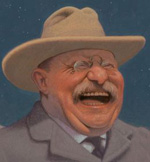 This exquisite picture book biography captures the exuberance of Teddy Roosevelt’s youth and his commitment to service. Roosevelt’s convictions and vision for the country were tested by numerous challenges. Did you know that that he was the first American to win the Nobel Peace Prize? As the twenty-sixth President, he worked tirelessly to make the country a better place (i.e. protecting the nation’s natural resources). The illustrations add life and warmth to punctuate Roosevelt’s robust personality. The timeline and related digital and print resources will undoubtedly guide readers toward further research into Roosevelt’s life.
This exquisite picture book biography captures the exuberance of Teddy Roosevelt’s youth and his commitment to service. Roosevelt’s convictions and vision for the country were tested by numerous challenges. Did you know that that he was the first American to win the Nobel Peace Prize? As the twenty-sixth President, he worked tirelessly to make the country a better place (i.e. protecting the nation’s natural resources). The illustrations add life and warmth to punctuate Roosevelt’s robust personality. The timeline and related digital and print resources will undoubtedly guide readers toward further research into Roosevelt’s life.
- Mary Napoli, Penn State Harrisburg
Kalman, Maira. (2014). Thomas Jefferson: Life, liberty and the pursuit of everything. New York: Nancy Paulsen Books.
 The picture book format of this book is deceiving. The bright colors, stylized art, and even the playful title may indicate a light style. However, the content of the book is thorough, honest, and quite sophisticated. The author does not shy away from presenting the difficult parts of Jefferson’s legacy (such as his attitude towards Native American and his views on slavery), but does so in a way that fosters critical inquiry. The informal style is highly accessible and the source notes contain plenty of invitations for further research. This biography stands out for showing a renowned leader as a complicated human being. Readers may walk away with more questions than answers, not only about Jefferson but about our country.
The picture book format of this book is deceiving. The bright colors, stylized art, and even the playful title may indicate a light style. However, the content of the book is thorough, honest, and quite sophisticated. The author does not shy away from presenting the difficult parts of Jefferson’s legacy (such as his attitude towards Native American and his views on slavery), but does so in a way that fosters critical inquiry. The informal style is highly accessible and the source notes contain plenty of invitations for further research. This biography stands out for showing a renowned leader as a complicated human being. Readers may walk away with more questions than answers, not only about Jefferson but about our country.
- Lesley Colabucci, Millersville University
Castrovilla, Selene. (2013). Revolutionary Friends: General George Washington and the Marquis de Lafayette. Illus. by Drazen Kozjan, Honesdale, PA: Calkins Creek.
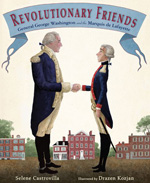 This little known story from Revolutionary times shows George Washington as a compassionate father figure and the young Marquis de Lafayette as both his protégée and a hero in his own right. The book functions as biography as readers get to know both Washington and the Marquis de Lafayette, Their voices and personalities come through even as the conflicts of the time period are highlighted. The book begins with a story format then transitions into more narrative nonfiction with timelines, primary source documents (Lafayette’s letters, etc.) and sidebars. The endnotes go above and beyond offering not only a bibliography but also a glossary of French words and information about related historical sites. This is a unique piece of nonfiction that varies in style throughout while playing on familiar elements of friendship during a time of war.
This little known story from Revolutionary times shows George Washington as a compassionate father figure and the young Marquis de Lafayette as both his protégée and a hero in his own right. The book functions as biography as readers get to know both Washington and the Marquis de Lafayette, Their voices and personalities come through even as the conflicts of the time period are highlighted. The book begins with a story format then transitions into more narrative nonfiction with timelines, primary source documents (Lafayette’s letters, etc.) and sidebars. The endnotes go above and beyond offering not only a bibliography but also a glossary of French words and information about related historical sites. This is a unique piece of nonfiction that varies in style throughout while playing on familiar elements of friendship during a time of war.
- Lesley Colabucci, Millersville University
Grades 6-8
Chew, Elizabeth. (2014). Thomas Jefferson: A day at Monticello. Illus. by Mark Elliott. New York: Abrams Books for Young Readers.
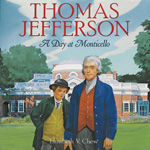 A former curator at the Monticello historical site, Chew presents a biography that celebrates and somewhat idealizes Jefferson. A strong artistic sensibility pervades the book and brings the setting alive with both archival images and new paintings. There is a personal feel to the story, which may the result of the time the author’s familiarity with the place. The text is highly detailed and offers an intimate portrayal of Jefferson’s daily activities, passions, and past-times. The issue of slavery is avoided by being embedded into a look at the plantation’s workings. Ultimately, this book might be ideal for President’s Day because it highlight only the positive but it certainly should be complemented with more balanced portraits of the Jefferson. The book could extend any study of Monticello, especially in conjunction with a field trip.
A former curator at the Monticello historical site, Chew presents a biography that celebrates and somewhat idealizes Jefferson. A strong artistic sensibility pervades the book and brings the setting alive with both archival images and new paintings. There is a personal feel to the story, which may the result of the time the author’s familiarity with the place. The text is highly detailed and offers an intimate portrayal of Jefferson’s daily activities, passions, and past-times. The issue of slavery is avoided by being embedded into a look at the plantation’s workings. Ultimately, this book might be ideal for President’s Day because it highlight only the positive but it certainly should be complemented with more balanced portraits of the Jefferson. The book could extend any study of Monticello, especially in conjunction with a field trip.
- Lesley Colabucci, Millersville University
Delano, M. F. (2013). Master George’s People: George Washington, his slaves, and his revolutionary transformation. Illus. by Lori Epstein. Washington DC: National Geographic.
 This books deals forthrightly with the first president’s experience with slavery. The information is contextualized through images of archival material and detailed descriptions of daily life during the time. The paintings do not quite mesh with the historical material at times but the large format and engaging endpapers (including excerpts from Washington’s will) add to the overall appeal. The author’s voice is of particular significance in this book because of her connection to Mt. Vernon. She is able to bring an intimate feel to the setting and sets up a great opportunity to talk to readers about objectivity and balance in nonfiction writing.
This books deals forthrightly with the first president’s experience with slavery. The information is contextualized through images of archival material and detailed descriptions of daily life during the time. The paintings do not quite mesh with the historical material at times but the large format and engaging endpapers (including excerpts from Washington’s will) add to the overall appeal. The author’s voice is of particular significance in this book because of her connection to Mt. Vernon. She is able to bring an intimate feel to the setting and sets up a great opportunity to talk to readers about objectivity and balance in nonfiction writing.
- Lesley Colabucci, Millersville University
Singer, M. (2013). Rutherford B., who was he? Poems about our President. Illus. by John Hendrix. NY: Disney Hyperion.
 Playful cartoon-style illustrations set the tone for this romp through all 43 presidents. Each president has his own poem introduced with his own party and years of office; many are accompanied by a quote as well. The illustration for each poem connects to a big event during that presidency (GW Bush stands atop 9/11 rubble, Nixon in front of the Watergate building), attempts to personify a character trait (Ford sits in a sinking boat, Taft in a bathtub), or identifies an iconic symbol (Lincoln’s hat, a hoe for Carter). The content of the illustrations offer plenty of opportunity for inquiry and further research. The poems themselves offer a unique balance between a silly rhythmic style with lots of rhyme and factual, historical information. There is ample back matter to substantiate the biographical elements and further contextualize the history. Readers may want to partner this text with Basher History: US Presidents: Oval Office All-Stars (2013) created/illustrated by Simon Basher and written by Dan Green, published by Kingfisher Children’s Books.
Playful cartoon-style illustrations set the tone for this romp through all 43 presidents. Each president has his own poem introduced with his own party and years of office; many are accompanied by a quote as well. The illustration for each poem connects to a big event during that presidency (GW Bush stands atop 9/11 rubble, Nixon in front of the Watergate building), attempts to personify a character trait (Ford sits in a sinking boat, Taft in a bathtub), or identifies an iconic symbol (Lincoln’s hat, a hoe for Carter). The content of the illustrations offer plenty of opportunity for inquiry and further research. The poems themselves offer a unique balance between a silly rhythmic style with lots of rhyme and factual, historical information. There is ample back matter to substantiate the biographical elements and further contextualize the history. Readers may want to partner this text with Basher History: US Presidents: Oval Office All-Stars (2013) created/illustrated by Simon Basher and written by Dan Green, published by Kingfisher Children’s Books.
- Lesley Colabucci, Millersville University
Grades 9-12
Freedman, Russell. (2013). Becoming Ben Franklin: How a candle-maker’s son helped light the flame of Liberty. New York: Holiday House.
 In this extraordinary biography, Freedman provides readers with insights into Benjamin Franklin’s early life. In nine accessible and informative chapters, readers learn about Franklin’s apprenticeship in Philadelphia, his generous spirit, robust energy, and friendly disposition. Readers will be interested to know that Franklin’s business acumen and civic engagements eventually launched his political career. Information about Franklin’s inventions and political contributions is included. Moreover, students with a penchant for research will find the additional source notes, timeline, and bibliography of particular interest. Freedman brings history to life and includes archival illustrations, portraits, and almanac and newspaper pages.
In this extraordinary biography, Freedman provides readers with insights into Benjamin Franklin’s early life. In nine accessible and informative chapters, readers learn about Franklin’s apprenticeship in Philadelphia, his generous spirit, robust energy, and friendly disposition. Readers will be interested to know that Franklin’s business acumen and civic engagements eventually launched his political career. Information about Franklin’s inventions and political contributions is included. Moreover, students with a penchant for research will find the additional source notes, timeline, and bibliography of particular interest. Freedman brings history to life and includes archival illustrations, portraits, and almanac and newspaper pages.
- Mary Napoli, Penn State Harrisburg
Bolden, Tonya. (2013). Emancipation Proclamation: Lincoln and the dawn of liberty. New York: Abrams Books for Young Readers.
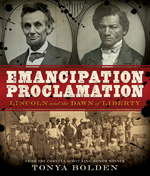 Bolden’s stellar research and personal writing style sheds light into the tensions surrounding Lincoln’s Emancipation Proclamation, his attitudes toward the nation’s free and enslaved, and whether the proclamation actually freed anyone. The book is organized into three sections, each providing the reader with various perspectives: the political pressures and arguments that Lincoln faced leading up to the Emancipation and the voices from African-American and Abolitionist communities. Archival photographs, illustrations, documents, political cartoons, an annotated timeline, source notes, index, and selected bibliography illuminate this powerful text. Bolden’s writing coupled with historical research and new insights will support content area instruction.
Bolden’s stellar research and personal writing style sheds light into the tensions surrounding Lincoln’s Emancipation Proclamation, his attitudes toward the nation’s free and enslaved, and whether the proclamation actually freed anyone. The book is organized into three sections, each providing the reader with various perspectives: the political pressures and arguments that Lincoln faced leading up to the Emancipation and the voices from African-American and Abolitionist communities. Archival photographs, illustrations, documents, political cartoons, an annotated timeline, source notes, index, and selected bibliography illuminate this powerful text. Bolden’s writing coupled with historical research and new insights will support content area instruction.
- Mary Napoli, Penn State Harrisburg
Swanson, J.L. (2013). The President has been shot: The assassination of John F. Kennedy. NY: Scholastic Press.
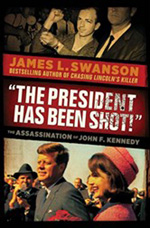 This book focuses on the assassination rather than the presidency of John F. Kennedy. The author is a historian whose past work for adults and young people has featured similar topics (Chasing Lincoln’s Killer in 2009 and Bloody Times in 2011). The lives of both Kennedy and Lee Harvey Oswald are both profiled to provide background information, but the heart of the story is the assassination itself. Readers are taken right to the day, really the moment the shooting occurred. The “true crime” feel of this portion of the book is followed by a more reverent exploration of the aftermath, including the funeral and the death of Oswald. The author does not equivocate regarding conspiracy theories. He makes his position clear, substantiating this stance by making his thinking and research process concrete and accessible to young readers.
This book focuses on the assassination rather than the presidency of John F. Kennedy. The author is a historian whose past work for adults and young people has featured similar topics (Chasing Lincoln’s Killer in 2009 and Bloody Times in 2011). The lives of both Kennedy and Lee Harvey Oswald are both profiled to provide background information, but the heart of the story is the assassination itself. Readers are taken right to the day, really the moment the shooting occurred. The “true crime” feel of this portion of the book is followed by a more reverent exploration of the aftermath, including the funeral and the death of Oswald. The author does not equivocate regarding conspiracy theories. He makes his position clear, substantiating this stance by making his thinking and research process concrete and accessible to young readers.
- Lesley Colabucci, Millersville University
Digital Connection: Websites and Related Apps
Teaching History Clearinghouse
Smithsonian National Portraits of the Presidents
Smithsonian Idea Lab
American Presidents App ($3.99)
The White House App (free)
These reviews are submitted by members of the International Reading Association's Children's Literature and Reading Special Interest Group (CL/R SIG) and are published weekly on Reading Today Online.
The CL/R SIG is accepting submissions to the fall 2014 edition of their journal, The Dragon Lode, through April 15, 2014. There is an open theme, and they invite manuscripts that explore contemporary issues and questions, genre study, literary theory, and research related to children's literature and reading. Manuscripts should be no longer than 20 double-spaced, typed pages. Use APA (6th edition) formatting. Author's name, affiliation, mailing address, telephone and fax numbers, and e-mail address should be on a separate cover page. Photos and illustrations should be sent as a separate jpeg file. Any reference to the author that would enable the reviewer to know the author's identity should not appear in the manuscript. Submit all manuscripts to: Dr. Ruth McKoy Lowery, Co-editor.
The International Reading Association partners with the National Council of Teachers of English and Verizon Thinkfinity to produce ReadWriteThink.org, a website devoted to providing literacy instruction and interactive resources for grades K–12.